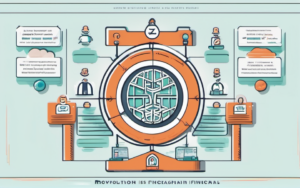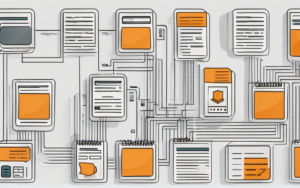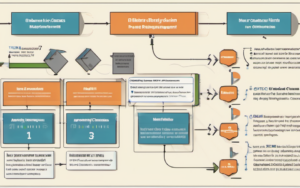In today’s interconnected digital world, establishing and maintaining blockchain trust is paramount. The sheer volume of data exchanged online, coupled with the rise of cybercrime, necessitates robust mechanisms to ensure authenticity and reliability. Blockchain technology, with its inherent security features, is emerging as a powerful tool to address these challenges, offering a novel approach to fostering trust in a digital landscape often characterized by uncertainty.
1. Introduction
1.1 The Evolving Need for Trust in the Digital Age
The digital age has revolutionized how we interact, conduct business, and access information. However, this interconnectedness comes with inherent risks. Online fraud, data breaches, and identity theft are increasingly prevalent, eroding public confidence in online systems. This lack of trust hinders innovation and limits the potential of the digital economy. Building robust mechanisms to ensure data integrity and secure transactions is crucial for fostering a trustworthy digital environment. The need for secure and transparent systems is more critical than ever before.
1.2 Blockchain Technology: A Foundation for Trust
Blockchain technology offers a potential solution to this crisis of blockchain trust. Its decentralized, transparent, and immutable nature provides a strong foundation for building secure and reliable systems. By recording transactions across a distributed network, blockchain eliminates single points of failure and reduces the risk of manipulation. This inherent security makes it an attractive option for various applications requiring high levels of trust and transparency, from managing sensitive data to securing online voting systems. The technology is proving to be revolutionary in its ability to reshape online trust.
2. Understanding Blockchain Technology
2.1 Core Principles of Blockchain
2.1.1 Decentralization
Unlike traditional centralized databases, blockchain networks distribute data across multiple nodes, making them resistant to single points of failure and censorship. This decentralization is crucial for building trust, as no single entity controls the data. This enhances the security and resilience of the system.
2.1.2 Immutability
Once data is recorded on a blockchain, it cannot be altered or deleted. This immutability ensures the integrity and reliability of the data, fostering trust among participants. This characteristic is critical for applications requiring high levels of data integrity.
2.1.3 Transparency
All transactions on a blockchain are publicly viewable (though participant identities may be pseudonymous), enhancing transparency and accountability. This transparency builds trust by allowing participants to verify the authenticity and validity of transactions. This open nature is a key element in building confidence in the system.
2.2 How Blockchain Works: A Simplified Explanation
In essence, blockchain is a chain of blocks, each containing a batch of validated transactions. Each block is cryptographically linked to the previous one, creating a secure and tamper-proof record. New blocks are added to the chain through a process of consensus, ensuring the integrity and validity of the data. This process makes it incredibly difficult to alter or delete information, underpinning the technology’s reputation for blockchain trust.
2.3 Types of Blockchain Networks
Different blockchain networks exist, each with unique characteristics. Public blockchains, like Bitcoin, are open to anyone and are characterized by high transparency and decentralization. Private blockchains, on the other hand, offer more control and confidentiality, making them suitable for enterprise applications. Permissioned blockchains provide a middle ground, offering a degree of control while still maintaining a level of transparency. The choice of network depends on the specific application requirements.
3. Blockchain Applications for Building Trust
3.1 Secure Data Management and Storage
3.1.1 Protecting Sensitive Information
Blockchain technology offers robust solutions for protecting sensitive information, ensuring data privacy and security. By distributing data across a network, blockchain minimizes the risk of single points of failure and data breaches, enhancing the overall security of sensitive data. This makes it an ideal solution for applications like healthcare and finance.
3.1.2 Ensuring Data Integrity
The immutability of blockchain ensures data integrity, preventing unauthorized modifications or deletions. This is particularly important for applications where data accuracy is critical, such as medical records or legal documents. This feature addresses a crucial aspect of building blockchain trust for sensitive information.
3.2 Supply Chain Transparency and Traceability
3.2.1 Enhancing Supply Chain Visibility
Blockchain can enhance supply chain visibility by providing a transparent and auditable record of product movement and origin. This improved transparency helps build trust between businesses and consumers, ensuring authenticity and reducing the risk of fraud. Using blockchain for transparent and trustworthy transactions improves the overall efficiency and accountability of the supply chain.
3.2.2 Combating Counterfeiting
The immutability of blockchain can help combat counterfeiting by creating a secure and verifiable record of product authenticity. Consumers can verify the genuineness of products by checking their blockchain records, increasing blockchain trust and reducing fraud. This improved transparency helps restore consumer confidence.
3.3 Digital Identity and Verification
3.3.1 Secure Identity Management
Blockchain can create secure and verifiable digital identities, making it easier to manage personal data and verify identities online. This enhanced security protects against identity theft and fraud, boosting confidence in digital interactions. This is a key application for enhancing digital trust.
3.3.2 Streamlining Verification Processes
Blockchain can streamline identity verification processes, making them more efficient and secure. This simplification reduces bureaucratic hurdles and enhances the user experience, fostering greater trust in digital interactions. This is a critical aspect of how blockchain trust can be leveraged in identity management.
3.4 Secure Voting and Elections
3.4.1 Ensuring Election Integrity
Blockchain can enhance election integrity by providing a secure and transparent record of votes. This transparency increases public confidence in the election process, reducing the risk of fraud and manipulation. This approach builds blockchain trust in the electoral system.
3.4.2 Enhancing Voter Confidence
By using blockchain to record votes, election officials can enhance voter confidence by demonstrating that the system is secure and resistant to tampering. This is critical for maintaining trust in democratic processes. This increased transparency makes the process more equitable and trustworthy.
4. Challenges and Considerations
4.1 Scalability and Performance
One of the major challenges facing blockchain technology is scalability. Current blockchain networks struggle to handle a large volume of transactions, limiting their applicability in certain contexts. Ongoing research and development are addressing these limitations.
4.2 Regulatory Uncertainty
The lack of clear regulatory frameworks for blockchain technology poses a significant challenge for its widespread adoption. Regulatory clarity is crucial for fostering trust and promoting innovation in this space.
4.3 Energy Consumption
Some blockchain networks, particularly those using Proof-of-Work consensus mechanisms, consume significant amounts of energy. This environmental impact needs to be addressed through the development of more energy-efficient consensus mechanisms.
5. The Future of Blockchain and Trust
5.1 Emerging Trends and Innovations
The field of blockchain technology is rapidly evolving, with new innovations and applications emerging constantly. Improvements in scalability, energy efficiency, and regulatory clarity will pave the way for wider adoption and integration of blockchain in various sectors.
5.2 The Potential for Widespread Adoption
The potential applications of blockchain technology are vast and transformative. As challenges are addressed and trust in the technology grows, we can expect widespread adoption, leading to a more secure and transparent digital ecosystem. The future of secure data management, transparent transactions, and enhanced digital trust heavily relies on the ongoing development and refinement of blockchain technology. The benefits of implementing robust blockchain solutions to address the challenges of the digital age are numerous and far-reaching. Addressing the existing challenges regarding scalability, regulation, and energy consumption will further solidify blockchain’s role in building a more trustworthy digital future.




